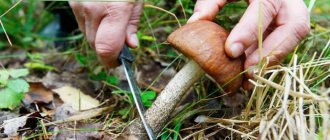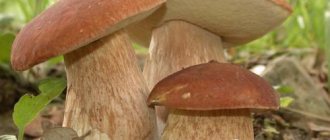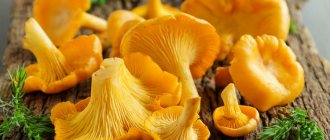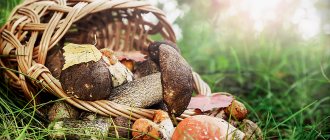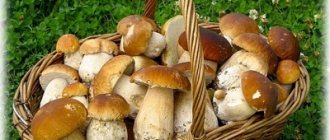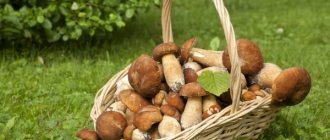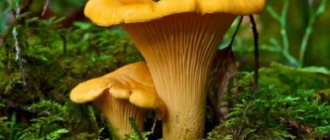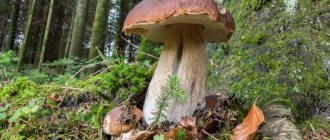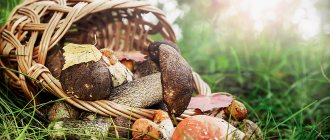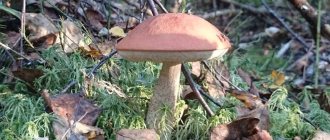Mushrooms in August
August is the richest month for mushrooms, especially starting in the middle. And what kind of mushrooms grow in August - a sight for sore eyes! These are royal white ones, and baby honey mushrooms, and red fox sisters, and cheerful little waves.
You will not find such a variety of mushrooms in any other month, be it summer or early autumn, rainy or dry day. Therefore, if you don’t often go out into the forest to pick mushrooms, then it’s better to go once a season, but in August you’ll pick enough to last the whole winter!
Mushrooms are unique! They are tasty and healthy. They can be fried, boiled, pickled, or pickled. They make great soups, wonderful potatoes, fragrant pies, thick sauces. This is why mushrooms are valued, this is why from year to year they go to forests and swamps to get them, wandering there all day long. And what mushrooms grow in August, and which of them can be found in our forests, you will learn from this article.
Butter
Butterflies are collected in coniferous forests. It got its name because of the oily cap that is slippery to the touch. It is used in soups, fried, salted, pickled, in sauces and side dishes; it is rarely used for drying, but is also suitable. Butterflies are relatively early mushrooms, and they can be collected in cleared pine forests from the first days of June. This period lasts no more than two weeks. Then the boletus disappears and appears again somewhere in the second half of July, and grows en masse from mid-August and the first half of September.
Honey mushrooms
Autumn honey mushrooms are called that because they usually grow in the fall, in September, after a cold snap. You can often come across entire trunks strewn with their fruiting bodies. One trunk is a basket. But experienced mushroom pickers even go for honey mushrooms with backpacks and bags; they can be compacted and they hardly wrinkle. And no matter what container you take for honey mushrooms, there is usually not enough of it.
“Honey mushrooms are especially tasty when marinated and fried. Only false honey mushrooms, such as the sulfur-yellow honey mushroom, are dangerous. But they are very easy to recognize by their yellow color and dark plates. For me, it’s very difficult to confuse them with our classic honey mushrooms,” Tikhomirov noted.
Porcini
Beginning at the end of June, the porcini mushroom appears. The porcini mushroom grows in both deciduous forests and coniferous forests; it prefers to be friends with spruce, pine, oak and birch. It is fried and boiled fresh in soups, stewed in roasts; they dry it and then prepare soups, borscht, bake pies, and make mushroom caviar. Porcini mushrooms are pickled and made into various snacks. The porcini mushroom is considered the most delicious and healthy mushroom. The porcini mushroom is collected from mid-June to the end of September, the most widespread collection is in the second half of August.
Milk mushrooms
Milk mushrooms are characterized by a light-colored funnel-shaped cap and a cylinder-shaped leg. There are many types of milk mushrooms, but, of course, our favorite and most valuable is the “real” milk mushroom, white in color, with a shaggy cap. You have to look for it in the birch trees. And sometimes it’s not easy: milk mushrooms like to hide under fallen leaves.
“The real milk mushroom, or the white one, or the shaggy one, in Rus' was valued even higher than the porcini mushroom. Well, because there is no more ideal mushroom for pickling. It is best to salt milk mushrooms in a “cold” way, that is, without any cooking: a layer of milk mushrooms, a layer of salt - and so on to the top of the jar or barrel. And there is pressure from above - the milk mushroom itself will release juice. They traditionally eat salted milk mushrooms with sour cream, well, not to mention that this is simply the best snack... But with salted milk mushrooms you can make pies and much more,” Tikhomirov advised.
RULES FOR MUSHROOMS PICKER
- Put in the basket only those mushrooms that you know, or at least can identify by appearance (if anything, your household will tell you which ones are best to throw away).
- Avoid picking mushrooms along roads, highways, or in areas treated with insecticides.
- Do not collect old and overripe mushrooms that have already begun to decompose. Microorganisms that are poisonous to humans can multiply in them.
- Collect mushrooms only in baskets or plastic buckets. In plastic or cellophane bags they wrinkle, deteriorate and may generally begin to decompose due to abuse.
- Mushrooms must be processed directly on the day of collection. If you do not do this on the first day, the mushrooms may become wormy due to the eggs laid in them by insects.
- Twist the mushrooms out of the mycelium, rather than cutting them with a knife, so that the stalk does not rot. Sprinkle the hole left after twisting the mushroom with earth so that the mycelium is not disturbed.
- Do not give mushrooms to small children to avoid causing heaviness in the stomach.
- Be sure to wash your hands after coming from the forest. Bacteria or poisons can accumulate on your hands (especially if you have touched poisonous mushrooms).
- Do not kick fly agarics and other inedible mushrooms. Forest inhabitants feed on them.
SHARE
Chanterelles
Chanterelles grow in mixed forests, but are especially fond of birch forests. At the same time, chanterelles never grow alone, but always in large families. The main advantage of these mushrooms is that worms almost never eat them. So you can safely add them to your cart!
“Among mushroom lovers, chanterelles are highly valued for their excellent taste and the almost complete absence of insect larvae (which we more often call “worms”) in the fruiting bodies. This is due to the presence of a special compound in the pulp - quinomannose, which is a natural shield of the fungus from parasites trying to feast on them,” Tikhomirov noted.
Poisonous and inedible mushrooms of August
The beginning of August and the last ten days of this summer month are marked by a decrease in temperature indicators over most of our country, which is very favorable for both edible mushrooms and poisonous and inedible varieties. About ten species of dangerous mushrooms are the most widespread in Russian forests. The massive peak of fruiting of deadly poisonous and inedible mushrooms occurs precisely in the last month of summer.
| Species name | Latin name | Spreading | Similar edible species |
| Patouillard fiber | Inocybe erubescens | Deciduous, coniferous, mixed forests, parks and garden areas. Prefers calcareous and clay soils. Most often forms mycorrhiza with beeches and lindens | Champignons and entolomas |
| Gray-yellow false honey fungus | Hypholoma fasciculare | Open grassy spaces - fields and gardens, roadsides, forest clearings | Sulphurous honey fungus and summer honey fungus |
| Row sulfur-yellow | Tricholoma sulphureum | Deciduous and mixed forests, lime-rich soils | Other types of rowing and russula |
| Brick-red false honey fungus | Hypholoma sublateritium | Decaying wood and stumps of deciduous trees in mixed or deciduous forests | Seroplate false honey fungus and other types of honey mushrooms |
| Galerina bordered | Galerina marginata | Typically grows on trees or near coniferous and deciduous trees | Edible species of honey mushrooms |
| Satanic mushroom | boletus satanas | Forms mycorrhizae with most foliage plants. Prefers forest areas with calcareous soils | Olive-brown oak and speckled oak |
| Waxy talker | Clitocybe phyllophila | On forest rotting fallen leaves and needles it grows in large groups with the formation of large “witch’s” circles | Other types of talkers |
| Death cap | Amanita phalloides | Prefers fertile forest soils, most often found in light deciduous and mixed forests | Champignon, green russula and greenish russula, floats, greenfinch |
| Common puffball | Scleroderma citrinum | Soil or rotten wood in light deciduous or coniferous forest zones, on the soils of young plantings, in meadows, forest edges and clearings | Edible varieties of puffball |
| Panther fly agaric | Amanita pantherina | Prefers forest areas with alkaline soils and forms mycorrhizae with almost any trees | Fly agaric gray-pink |
It should be remembered that poisonous types of mushrooms pose a particular danger to children, and the number of deaths after eating such fruiting bodies reaches 90% or more.
boletus
The boletus, like the boletus, belongs to the genus Leccinum or Obabok, and is similar to it in many ways. The color of the cap ranges from light gray to dark brown. This parameter depends on which tree the mushroom grows next to. His hat is hemispherical and pillow-shaped. In humid weather conditions it becomes covered with light mucus.
Boletus grows well in August in deciduous, mainly birch, and mixed forests.
In addition to the color of the cap, boletus mushrooms are distinguished from boletuses by the absence of clearly noticeable scales on the stem. When the stem is cut, the flesh does not turn blue.
The boletus mushroom is easily confused with the gall mushroom. Bitterweed is not edible, has no poisonous properties, but tastes disgusting. It has “greasy” flesh and a mesh-shaped pattern on the surface of the stem.
What mushrooms grow in the garden in autumn?
What edible mushrooms grow in autumn?
- Porcini
- Oyster mushroom
- Gruzd
- Edible hedgehog
- Umbrella blushing
- Chestnut mushroom
- Kid
- Chanterelle
Interesting materials:
How to delete the Google music app? How to delete the YouTube application on your phone? How to remove an application from quarantine? How to remove an application from the list? How to remove the mail application from your phone? How to remove an application from a Windows 8 computer? How to remove an application from a Samsung phone? How to delete the Sberbank application on your phone? How to remove the Skype application from your phone? How to uninstall YouTube Chrome app?
Mushroom places in Russia
In the most “mushroom” countries, mushroom picking is quite strictly regulated by law, so compliance with the collection rules is closely monitored. In many countries of the world there are special mushroom clubs, and various mushroom travel maps have been developed, thematic festivals are held, where you can try the most exotic species.
Of course, mushroom tourism in our country has not yet become as widespread as possible, however, the popularity of “quiet” hunting is obvious. The following areas and regions of our country are among the most popular and productive mushroom places among domestic mushroom pickers:
- Tver region, at the recreation center “Medveditsa”;
- Tomsk region, as well as the territory of Altai and Krasnoyarsk Territory, where procurement companies specializing in the processing of mushroom products are located;
- Vladimir and Yaroslavl regions;
- a significant part of the Moscow region;
- the village of Mikheevo, Komsomolsky district, Kaluga region;
- central and western regions of Karelia;
- Kondopoga district - the village of Girvas, the village of Krasnaya Rechka, Tulgube and Luchevoy;
- Loukhsky district, near Lake Engozero;
- Gatchina, Vyborg, Priozerny and Volkhov districts of the Leningrad region;
- Kirovsky district near the village of Sinyavino and the village of Gory, Leningrad district.
The undisputed leader in the number of mushroom places is deservedly Karelia. It is difficult to evaluate mushroom places by productivity, since every year the yield pattern changes depending on external factors, including weather conditions.
What mushrooms can be picked in August (video)
| Species name | Latin name | Category | Spreading |
| Meadow honey fungus | Marasmius oreades | Fourth | Open grassy spaces - fields and gardens, roadsides, forest clearings |
| Oiler grainy | Suillus granulatus | Second | Well-lit spruce forests with sufficient soil moisture |
| Boletus | Leccinum versipelle | Second | The main distribution area is represented by deciduous, coniferous and mixed forests in the central zone of our country |
| Pluteus deer | Pluteus cervinus | Fourth | Grows mainly on stumps and woody remains of coniferous species, mainly spruce |
| Spiky raincoat | Lycoperdon perlatum | Fourth | Forest zones of different types and meadows, dead wood |
| Field champignon | Agaricus arvensis | Third | Mainly in deciduous forests with humus-rich soils |
| Funnel talker | Clitocybe gibba | Fourth | Distributed almost everywhere in our country |
| Real milk mushroom | Lactarius resimus | Third | Under rotting fallen leaves in shaded and humid forests |
| Poddubovik | Boletus luridus | Second | Grows on hills and slopes with high levels of humidity, in mixed and deciduous forests |
| Russula | Russula | Third | The main distribution area is represented by deciduous, coniferous and mixed forests in the central zone of our country |
Ryzhik
Saffron milk caps are a group of mushrooms belonging to the genus Mlechnik of the Russula family. They grow in coniferous forests. They are considered useful because they contain a number of microelements and vitamins. This mushroom helps accelerate the growth of hair and nails, and also improves vision. In pharmacology, its natural antibiotic lactarioviolin is used, the components of which can suppress the growth of tubercle bacilli.
Thanks to its “outstanding” appearance, the saffron milk cap is difficult to confuse with other mushrooms, except for the safe pink mushroom.
Saffron milk caps can improve vision
Distinctive features of saffron milk caps:
- The cap is large, concave inward (wide-funnel-shaped), the edges are bent, then straight.
- At the bottom of the cap there are frequent yellow-orange plates that turn green if you press on them.
- The leg is 2-8 cm high, cylindrical, hollow, painted in the same colors as the cap.
- Color ranges from light yellow to bright orange. There are red and blue-green representatives.
- The milky juice is abundant, orange, sweetish in taste, with a fruity aroma, and turns green in the air.
Signs
Newbies are not always lucky enough to fill their cart. To avoid such a failure, you need to take into account several signs.
For example, if you come across thickets of ferns, then there will be boletuses nearby. In the forest, where mainly fir and aspen grow, there are many saffron milk caps, umbrellas and waveworts. There should be porcini mushrooms near fly agarics, and honey mushrooms growing near stumps and fallen trees. Also in August you can find milk mushrooms, sweet nuts and russula.
More than 100 species of edible mushrooms grow in August. Therefore, if you go into a dense forest, there is almost no chance of returning with an empty basket.
Tips for mushroom pickers
Mushrooms are very nutritious and tasty. If you follow some rules for collecting them, the mushroom season will bring a lot of joy and positivity. Experienced mushroom pickers gave some tips on how to pick mushrooms correctly.
If a lot of fly agaric mushrooms grow in a clearing along with other mushrooms, then this area is considered clean, and edible mushrooms can be collected from it. If only russula grow at the edge of the forest, then you should not touch them, since the soil is most likely contaminated. You should not go looking for mushrooms in impassable thickets; most mushrooms grow on the edges, small clearings and young plantings.
Average mushroom growth, from 1 to 3 days. For lamellar mushrooms, the optimal temperature is 10-20 degrees, for noble mushrooms - 5-15 degrees above zero. In this case, it is necessary to pay attention to the air humidity, it should be 80-90% (it is very good to collect mushrooms after rain, after heavy dew).
Only those mushrooms whose caps are not fully opened or are partially opened can be eaten. If the cap of a mushroom is open like an umbrella, then it no longer represents any nutritional value; it is better to hang it on a branch so that the spores spread throughout the area. If the mushroom cap has the shape of a dome, then such a mushroom cannot be eaten. It has already released spores and a poison (similar to a corpse) is forming in it. It is because of such mushrooms that people most often experience poisoning.
Subject:
- Mushrooms
